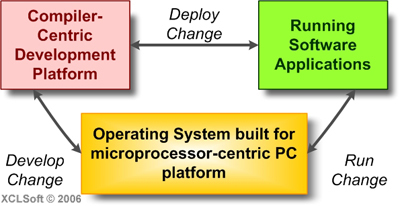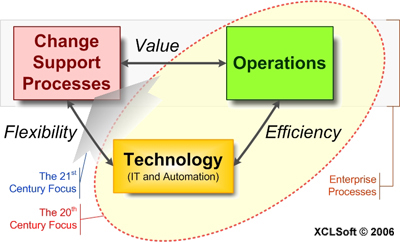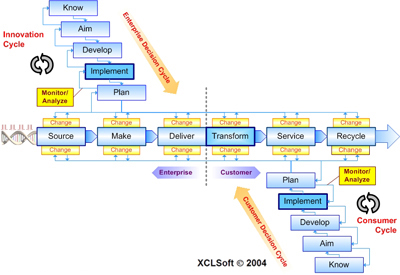|
|
 Dynamically Stable Enterprise—Redefining
the Enterprise
Information Architecture for
the Future Dynamically Stable Enterprise—Redefining
the Enterprise
Information Architecture for
the Future
|
|

|
Claming an
enterprise roadmap valid for many
decades for one of the key
element of the entire society is a
very bold statement. Despite the
obvious progress made in the
technology, organization structure,
collaboration, there are very few
innovations throughout the history when comes to the
enterprise fundamentals. One of the
most important concepts for the
productivity increase, the assembly
line invented by Henry Ford, took
almost a century to reach the highly
sophisticated, completely automated
microprocessor manufacturing lines.
In other fields, like the microprocessor architecture,
billions of transistors were only added
on the same basic structure that
existed decades ago. Even
programming languages have evolved
very little from their first design.
Most of the elements from the first
programming language, FORTRAN, can
be found in any of the latest logic
structures.
Even the Internet, with its
extraordinary ramp-up usage, has
changed relatively very little from
the initial architecture.
Nevertheless, a faster pace made the need to integrate
change, operations,
and technology one of the one
of the biggest challenge that
emerged in this new millennium. A solution
for this challenge will shape in a
fundamental way the future of the
enterprise for decades to come. Beyond the
highly automated assembly lines, the
only long term solution to a
long-term increased productivity is
if key processes, like the new product
development, can become highly
automated as well. Its success is
dependent on a creating enterprise
Information Architecture that will
integrate the decision-making,
change management, and
operations in a unique framework.
The only way to deal with a
complexity so high when designing
such an enterprise infrastructure,
is if an engineering approach is
taken, one that has a top-down
analysis, and a bottom-up
implementation.

Flexible
Microprocessor-Centric
Architecture |

Flexible DSE-Centric
Enterprise Architecture |
|
There is a clear
parallel between the two
architectures. There is
a major difference
between them. While the
PC architecture takes
changes in a discrete
way, in an enterprise
pausing and starting
operations is a very
costly process. To be
able to truly take
advantage of
flexibility, the
enterprise should be
able to not only to
implement changes
without stopping the
operations, but to
implement multiple
changes at the same
time. The end result is
a highly efficient and
continuously-adaptive
enterprise
|
It is well proven that success is
one of the key factors of success.
As Craig Barrett from Intel observed
recently, the
main reason why the PC platform was
so successful was because it was
flexible. Using the same hardware
and operating system, countless
applications can be developed,
deployed, and run. When comes to the
enterprise, the same path can be
take. By introducing flexibility at
the foundation of the enterprise,
the same infrastructure is capable
to support the way changes are
introduced and run the operations.
Nevertheless, there is a major
difference between the PC and the
enterprise. Software applications
can be deployed only by stopping the
previous ones that are performing
the same function, resulting in a
change management that is
discrete in its nature. In the
enterprise, stopping and restarting
operations is extremely costly in
time and effort. The only one that
is truly effective is if the change
management is performed while
operations are continuing to
run.
|

The
Dynamically Stable
Enterprise (The Complete
Enterprise Dashboard or "The
Chair Diagram") focus is on
integrating the enterprise
internal decision-making
process that ensures the
flexibility of the
enterprise. |

Many
decades away, possible as a
22nd century architecture,
the Dynamically Stable
Customer-centric
Environment may allow
customers to drive multiple
enterprises at the same
time; products are
customized to collaborate
together when in use |
|
Key to both concepts is
an integrated
Information
Architecture, obeying
the information laws of
the systems
architecture. While the
DSE has the enterprise
flexibility as focus,
the DSC has the
flexibility of the
customer environment as
a focus. Nevertheless,
the same principles
applied in the first
place can be easily
extended to the second
type of architecture.
The fields benefiting
the most, are the health
care, especially
preventive care, which
is required to be
efficient and
continuously-adaptive
process centered around
every customer
|
The flexibility is always
determined by the decision-making
process, especially the internal
one. While the customer
decision-making process, a process
used by all customers to decide if
they need to buy a certain product
or service, is very difficult to
integrate, it can be simplified by
approximating with a model of its
operations. The same model, together
with the operations one , and with
the business model, are the main
driver for how the operations are
run, and how new products and
services are developed.
The
DSE-centric infrastructure may
encompass thousands of standard
modules, all of them integrated
according to the laws of information
for systems architecture. Writing
software to implement these modules,
together with their deployment in
all the existing enterprises may
take many decades. Nevertheless, the
benefit could be tremendous. Flat
organizations, in which information
and products are flowing with
maximum of efficiency, will be
capable to mass produce
individualized products, at a cost
far lower than today's market. Once
this phase is completed, the same
standardized architecture can be
extended to a dynamically stable
customer-centric environment. In
this case, a customer's decision
will not only be the solely driver
for the entire value chain, but the
resulting products will be able to
collaborate while in use to optimize
their operations based on existing
needs. An industry that may fit
perfectly this model is the
preventive healthcare, one of the
most efficient way to provide
medical services. An environment in
which customized, complex medical
devices are continuously
manufactured at a low cost, their
collaboration automated with high
level summary information provided
continuously to existing hospitals,
can represent the ultimate in health
care. If implemented on a wide scale
in the next century, may lead to
name it the "Healthcare Century."
Nevertheless, as in a
microprocessor, billions and
billions of transistors can be added
on the same basic structure,
thousands and thousands of new
information processing modules can
be added on the same basic
infrastructure.
Obviously,
the new approach requires that
engineering schools and the MBA
programs to teach a different
perspective on the enterprise change
management, and on management in
general. Current MBA programs are
using the case-study approach, a
methodology more closer to the chess
players training than a business
manager that has to deal with many
unknown previously situations. They
have to learn more about information
flows, business modeling, process
integration, and business change.
Engineers need also to learn the
same skills. In the end ideally both
will have a major impact by
contributing equally to the overall
effort.
Another
important aspect for such an
infrastructure is the patenting
process. If successful, such an
infrastructure may require the
contribution of many businesses, and
many consultants. By patenting key
concepts, it will hinder its
development and adoption, for the
benefits of few. Our belief is that software should
not be patented. In fact, if the DSE
will prove to be successful, we are
planning to have an online catalog
with contributions of open
ideas. They may constitute prior art
for patenting attempts when comes to
practical applications
inspired by the DSE. The model for
this approach is
the Internet. If Tim Berners-Lee
would have patented the browser
architecture, it is unlikely that
the Internet would have become so
successful.
|
 The
DSE Fundamentals in a
Nutshell The
DSE Fundamentals in a
Nutshell
|
|

|

|
 Advantages
for Using the DSE vs.
Other Frameworks Advantages
for Using the DSE vs.
Other Frameworks
|
|

|

If you have any challenging
project and you think that it may
benefit from the use of the DSE
please let us know. The framework
and the methodology can be improved
from these experiences.
|
 Thank
You Thank
You
|
|

|
We expect that in
the next few weeks to add more
content and details regarding the
collaboration. Nevertheless, they
will be heavily influenced by your
praises and criticism, your
questions and suggestions. We accept
sponsorship. Anyway, please be
patient with our answers, as our
resources are very limited. Our
focus on the next few weeks is to
finish the book, and release it to
the editor. More
details about the framework are also
covered at xclsoft.com, the Web site
dedicated to our business, as our
way to capitalize on the
opportunities brought forward by the
DSE. We also
understand that at first the entire
concept is very confusing, and looks
extremely complex. The enterprise is
extremely complex, and as a first
attempt to unify all the elements,
it is a lot to digest.
Thank you for
visiting us! |
|